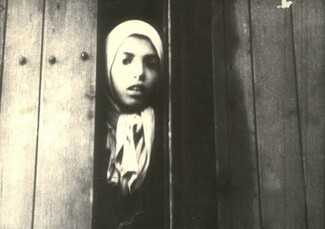The girl in the cattle wagon

EACH January I wait for her.
And she always comes, the beautiful girl in the cattle wagon, featured on every documentary about the Holocaust.
You've probably seen her. She peers through the slit of a closing door, her face - half hidden in dark shadows - framed by a white scarf.
There, on the platform are the Jewish prisoners, being pushed onto the train. And the child stares out at us, a silent, haunting image.
I always wait for the documentary narrators to say, "This girl is a Sinti child, a Dutch Gypsy."
But they never do.
The girl glides away, along with her tragic fellow passengers, away to Poland, to Auschwitz, to Death.
It was Dutch journalist, Aad Wagenaar, who discovered the child's identity. Wagenaar spent many months in the 1990s searching for the facts behind the famous image we see each year. He discovered that the unidentified image, often illustrating the suffering of Jewish Holocaust victims, was in fact, a clip from the "Westerbork film."
Wagenaar's quest led him to the homes of Jewish Auschwitz survivors, to war archives in Amsterdam, and finally, to a caravan site in Spijkenisse. It was there, in a trailer, he met Crasa Wagner, a Gypsy survivor who remembered the child and confirmed who she was.
The girl was a Romani called Settela Steinbach. She died with her mother and most of her siblings on 'Zigeunernacht' – July 31st 1944. The killings continued until dawn. Settela was nine years old.
Fifty years later, Aad Wagenaar published an account of his search. He called his book SETTELA.
Here is a list of some other books covering the Gypsy Holocaust. If you like them, please recommend them to schools and public libraries.
(Suitable for children aged eleven upwards, as well as adult readers)
AND THE VIOLINS STOPPED PLAYING by Alexander Ramati
This book recreates the world of the Lowland Gypsies of Poland during World War II. Roman and his family are sent to Auschwitz, where most are murdered on "zigeunernacht". Roman manages to escape.
SOFIA Z-4515 by Sofia Taikon, Gunilla Lundgren.
The story of Sofia Taikon, a Polish Gypsy who survived Auschwitz. Sofia was taken to Sweden where she met Gunilla Lundgren, the famous writer. Together they recorded Sofia's life and experiences. SOFIA Z-4515 is presented in comic-strip form, the title referring to the prison tattoo on Sofia's arm.
SETTELA'S LAST ROAD by Janna Eliot
A historical novel about Settela Steinbach, based on facts in Aad Wagenaar's book.
More books about the Romani/Sinti Holocaust for older children and adults.
SETTELA by Aad Wagenaar
An intriguing and emotional account of how the Dutch author discovered the truth about "the girl in the cattle wagon."
CHILDREN OF THE RAINBOW by Moris Farhi
Auschwitz ,1944. Little Branko is smuggled out of a concentration camp, and eventually adopted by a Swiss couple. Haunted by visions, he embarks on a search to find his biological family and fulfill his destiny. An interesting mixture of fantasy and realism.
A FALSE DAWN (My life as a Gypsy woman in Slovakia) by Ilona Lačkova
An account of how the author and her family survived life during and after the War.
FIRES IN THE DARK by Louise Doughty
An epic book describing the rise of Nazism in Bohemia and the calamity of World War II. Yenko, imprisoned with his family in a concentration camp, endures savage treatment and near starvation. He escapes, and the story ends on an optimistic note.
DUKE OF EGYPT by Margriet de Moor
Set in Holland shortly after World War II, Margriet de Moor describes the life of a Sinto whose family were killed by the Nazis. Beneath the peace of a Dutch village throbs the memory of war, betrayal, and reminders of ancient Gypsy traditions.
ZOLI by Colum McCann
Struggling to survive World War II in Czechoslovakia, Zoli is constantly on the move with a band of harp-playing Roma. Praised as a poet by Communist leaders, her work is used to integrate "our Gypsy brothers and sisters" into the glorious revolution. Zoli realises with horror that integration involves destroying caravans and forcing her people to live in high rise tower blocks.
TORN AWAY, FOREVER by Yvonne Slee
A collection of anecdotes about the author's Sinti family who lived in Germany under the Nazi regime.
BURY ME STANDING by Isabel Fonseca
This travelogue records Fonseca's passage through Europe, living with Gypsies. There's a chapter on the Devouring, (Holocaust), and many other references to Holocaust events.
WINTER TIME by Walter Winter
Memoir of a German Gypsy who survived the Second World War. At the start of the war, he enlisted in the German army but was later imprisoned in a concentration camp because of his Gypsy heritage. A realistic account of the savagery he both witnessed and endured.
WE ARE THE ROMANI PEOPLE by Ian Hancock
An informative book with a whole chapter called O BARO PORRAJMOS, describing the Romani Genocide.
THE DESTINY OF EUROPE'S GYPSIES by Grattan Puxon, Donald Kenrick
A factual book about the fate of the Romanies during the war.
These are just a few of the titles relating to the Romani/Sinti Holocaust. There are many, many more. If we let the wider public know about them, perhaps next year, when Settela, the girl in the cattle wagon appears on our screen, she will be given her rightful identity.